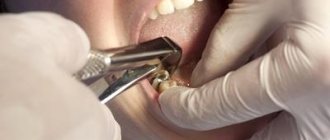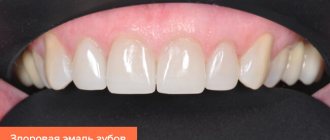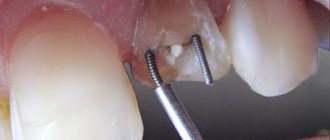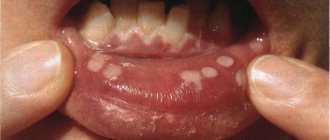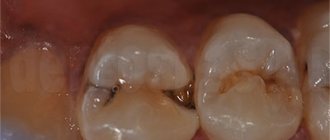Crowns, as a simple, functional and inexpensive form of prosthetics, continue to be widely used throughout the world. Severe destruction of enamel, pathology of the root system, loss of the entire tooth - these and other factors are indications for a visit to an orthopedist. But even competently done work cannot always guarantee the absence of force majeure circumstances. What to do if the crown comes off? This question is often asked by our patients. The main thing is not to panic and see a doctor as soon as possible. The specialist will easily find out the reason why the crown fell off, restore the previous aesthetics, and take measures to eliminate such incidents in the future. The VivaDent clinic employs real professionals who know what to do in such cases. Having your own dental laboratory makes it possible to quickly solve the problem of a broken crown.
Navigation
- Advantages of prosthetic crowns
- Why does the prosthesis fall?
- First actions
- Precautionary measures
- We will definitely help!
Reasons why crowns fall out
Why does a dental crown come off? This may happen for the following reasons:
- poor-quality cementing composition: many patients believe that this is the primary reason. But the main purpose of cement is not so much to fix the orthopedic structure on the tooth (in a good way, it should “sit” on it very tightly even without the use of dental glue), but to seal the gap between the tooth’s own tissues and the prosthesis,
- errors during preparation: when preparing a tooth, removing a nerve, taking impressions (molds), when installing a pin or stump inlay,
- errors in the manufacture of an orthopedic structure: ideally, the inside of the prosthesis should exactly repeat the shape of the stump. The discrepancy between the internal cavity of the prosthesis and the shape of the ground tooth is the main reason why the dental crown flies off,
- the bite is broken: during the treatment process, occlusion must be taken into account1, since improper closure of the dentition can lead to chips in the enamel, as well as damage and peeling off of artificial structures on the teeth,
- the patient did not follow the rules for using dentures: excessive load from hard foods, poor oral hygiene, improper use of floss or the use of toothpicks - as a result, the cement inside crumbles, inflammation and neoplasms may appear under the roots,
- diseases of the oral cavity: gum recession (decrease in level) against the background of prolonged inflammation of the soft tissues exposes the tooth roots, and the denture no longer contacts the gum. Food can get stuck under it, especially if the cement along the contour begins to deteriorate - and as a result, caries develops,
- The service life of the structure has come to an end: for plastic “caps” it is 3 years, for metal-ceramic ones – 5-7 years, and for zirconium dioxide – from 20 years; temporary crowns can be worn for only a few months.
REPROSTHETICS WITH ACRYLIC PROSTHETICS - RUB 200,000.
Re-prosthetics with an acrylic bridge on a metal frame (all included) up to 12 units.
Save RUR 30,000. Call now or request a call
Popular means
Dental stores sell many products for fixing crowns. There are many manufacturers, and many of them produce reliable products. How to glue a dental crown at home? The best types of glue are:
- "Rox". The product is produced in Russia, performing fixation for 12 hours. The glue is economical, since one tube is used within 1.5-2 months. Since it contains no harmful dyes, it is considered completely safe.
- "Forest Balsam" Used in the dental field to secure both removable and partial dentures. This glue ensures high-quality fastening of crowns during chewing. The composition contains rose hips and chamomile, which prevent inflammation. The tube is designed so that the glue can be conveniently applied to the desired surface.
- "Lakalut." High-quality fixing agent produced by a German manufacturer. Compared to its competitors, this product secures dentures for a day. Once secured, the denture cannot fall off during chewing or speaking.
- "The president". This product is available in almost all dental stores and pharmacies. Vaseline and various flavorings were used during production, so if the crowns were installed recently, it is not advisable to use such a product. The fixation weakens when eating hot food.
- "Fittydent." If you have severe sensitivity, this glue should not be used, as its application can lead to unpleasant sensations in the gums. To eliminate problems after application, you should wait before fixing the structure.
- "Protefix". For dentures, this is an effective tool that reliably fixes crowns for up to 12 hours. The composition contains mint and aloe, making the glue hypoallergenic.
- "Corega." Petrolatum, zinc, and paraffin were used to create the glue. The combination of these components ensures maximum fixation of the prosthesis without a negative effect on the body. There are several types of products from this manufacturer. Among them are refreshing and adhesive for strong fixation.
These are not all means for fixing dental crowns; there are over 30 of them. You need to know all the features of each means in order to choose the most suitable option.
What size should the ground base (stump) be for installing a crown?
- as high as possible: in this case, the structure will effectively withstand lateral loads (when the jaw moves to the sides) and will not break along with the tooth,
- as wide as possible, have parallel side walls (i.e., close in shape to a cylinder): many dentists grind the stump in the form of a “herringbone” or cone, leaving the top thin and not resistant to loads. The key to high-quality fixation is the maximum preservation of your own tissues and the correct shape, which allows you to withstand normal chewing pressure,
- at the base of the ground stump there should be a ledge or a small step, which ensures a tight fit of the crown to its own tissues in the gum area.
A tooth has rotted under the crown: what to do?
If a tooth rots under the crown, then you need to keep in mind that this process is no longer reversible. It will continue until the tooth tissue on which the crown rests rots completely, after which the crown falls out (Fig. 4). Signs that the tooth is rotting are the following symptoms:
- bad smell from under the crown,
- food getting under the crown,
- root caries is visible at the lower edge of the crown,
- the tooth under the crown has turned black (if the crown is made of metal-free ceramics, then its darkening can serve as a symptom of carious damage to the tooth tissue under the crown).
Caries of the tooth root under the crown on an x-ray (Fig. 5-6) –
The best diagnosis of this process is to contact a dentist, who will be able to detect caries even on surfaces that are difficult to inspect. The onset of carious lesions on the root surface at the lower edge of the crown can be difficult to diagnose if caries occurs on the lateral surfaces of the tooth root, i.e. in the interdental space (24stoma.ru).
In the latter case, a targeted photograph of the tooth is taken (Fig. 5-6), in which caries under the crown looks like intense darkening, unusual for healthy tooth tissue. Keep in mind that early contact with the dentist in such a situation can sometimes allow the tooth to be treated and a new crown installed. Late treatment, on the contrary, brings you closer to tooth extraction.
Tooth rotting under the crown: video
What should the internal cavity of the prosthesis be?
The crown on the tooth must completely repeat the geometric shape of the prepared tooth. Please note that it should not fly off during fitting - if the doctor has to support it with his finger, this is a bad sign. With a high degree of probability, such a product will not be securely fixed, and after a few months or a couple of years the patient will discover that the dental crown has fallen off. A correctly created structure holds securely even without glue-cement - solely due to its tight fit to the tooth’s own tissues.
CAD/CAM equipment is used for the production of all-ceramic dental crowns and prostheses from zirconium dioxide and aluminum, as well as the milling of metals (for example, titanium). The price of artificial teeth made using CAD/CAM technology is usually higher than traditional metal-ceramic ones. However, due to the high precision of manufacturing, such structures have a much longer service life.
Contraindications
The glue has almost no contraindications for use, excluding individual intolerance of the body to the components of the composition. During use, you need to make sure that the amount of glue is sufficient. It should not be released when the dental crown is compressed. If you follow the instructions provided by the manufacturer correctly, the glue will be completely safe. An overdose of the drug is rarely observed.
How is an overdose diagnosed and what symptoms appear? You may experience allergies, dizziness, weakness, sleepiness, excessive salivation, digestive problems, or nausea. At the first symptoms of an overdose, you must stop using the glue and consult a doctor.
In what cases can a fallen crown be put back?
Re-fixation of a permanent crown is possible if the following conditions are simultaneously present:
- if the supporting tooth is intact, has no chips or cracks,
- there is no need to treat/grind the tooth,
- if the prosthesis is not damaged or only slightly damaged: a small chip of ceramic on the metal “cap” can be restored.
It is also possible to reinstall a fallen temporary plastic or composite prosthesis. But all of the above conditions must also be met.
“A month and a half ago, I began to notice that the dental crown was moving out or seemed to be tilting. There was still no time to get to the doctor, and somehow I didn’t attach much importance. And while celebrating my sister’s birthday, I felt like I was chewing something wrong in my mouth. It turned out that the crown fell off while eating! I put it on a napkin and in my pocket. And the next day I went to the dentist. He examined everything, took an x-ray and said that we can glue it back and walk like this for a year or two.”
Alexander, review from the site irecommend.ru
When the old denture cannot be glued into place
In a situation where a crown has fallen off a tooth, in the vast majority of cases it is not possible to fix it back. This is mainly because it is quite difficult to remove hardened cement from the support or from the inside of the “cap” without damaging living tissue or the material of the prosthesis. The structure itself will eventually “sit” loosely on the support (since the stump has been ground again), or after 1-2 months the person will notice that the dental crown is falling off again. Also, the dentist may refuse to install the fallen prosthesis back if there are factors that will be discussed below.
Complex on 4 OSSTEM implants with delayed loading - 140,000 rubles.
Complex implantation Osstem (South Korea) with delayed loading after 4-6 months.
Doctor's work guarantee - up to 5 years (under an agreement on the provision of medical services) Call now or order a call
Opening hours: 24 hours a day - seven days a week
The prosthesis fell out along with the pin or stump insert
The pins and stump inlays are installed with the lower edge into the canals of the dental roots and secured with cement. And it is impossible to remove cement from narrow roots without dissecting part of your own tissues. Those. you will have to make a new inlay, because it must fit tightly to the walls of the canals (as well as a prosthesis, which inside repeats the shape of the top of the inlay). The pins have a standard shape, not a custom one, but they are very thin and often break off in the canal, i.e. With the prosthesis, only part of the pin falls out, while the other remains “walled up” in the canal. There is only one way out - to remove the entire tooth.
There is inflammation or cracks in the stump or root
A doctor can easily determine the presence of caries by darkened enamel, dentin, and a carious cavity on the stump. This requires drilling out all affected tissues, restoring the shape of the support and strengthening it (for example, with a filling or stump inlay). But it will not be possible to exactly repeat the original form.
Caries and cracks in the roots are detected using X-ray diagnostics or more accurate computed tomography. Depending on the situation, the dentist either goes through the canals, strengthens them with pins and fills them, or installs a core inlay, which will give strength to the restoration. Of course, it is impossible to reinstall the old structure in these situations.
Not only the prosthesis fell out, but the entire tooth along with the root
This happens in severe forms of periodontitis, periodontal disease, with massive cysts and granulomas at the roots. These formations appear against the background of the penetration of infection from the root canal into the periodontium - the ligamentous apparatus connecting the root to the bone socket. If a tooth falls out, you need to select a different type of prosthesis.
Find out more on the topic
We have collected more useful information about why a tooth crown falls out:
- Microprosthetics
- Stamped crowns
- Ceramic crowns
Literature used for the article:
- Orthopedic treatment of dental crown defects with artificial crowns / S.A. Naumovich. ― Minsk: BSMU, 2011.
- Method for clinical production of temporary crowns / V.I., Shemonaev, A.A., Maloletkova, O.Yu. Pavlova ― Volgograd scientific and medical journal, 2012
- Orthopedic treatment with fixed prostheses / Stefan F. Rosenstiel, Martin F. Land, Yunhai Fujimoto. ― Moscow “MEDpress-inform”, 2010
Author of the article: Natalya Aleksandrovna Kozlova
Copywriter of the information portal Stom-Firms.ru. Specializes in medical and dental texts.
First aid rules at home
Loss of prosthesis fixation quite often occurs unexpectedly for a person who is confused at first and does not understand what to do. Therefore, you need to know what to do if a dental crown comes off:
- carefully remove it from your mouth immediately and do not swallow anything that is currently in your mouth,
- rinse your mouth immediately: first with warm water and then with an antiseptic solution (for example, Chlorhexidine),
- rinse the denture with water and antiseptic: be careful that the product does not fall into the drain hole. It is better to rinse it over some container and in a well-lit place,
- dry the prosthesis, wrap it in a sterile bandage and put it in a dry, clean container,
- make an appointment with an orthodontist in the near future: it is better to go to the doctor who installed the prosthesis that fell out,
- while waiting for your appointment, you can take a painkiller tablet if there is bothersome pain: if there is no pain, then there is no need for medication,
- switch to a gentle menu: exclude hard, viscous, spicy foods, as well as canned food with acetic acid. The temperature of the food should be approximately equal to body temperature,
- try not to chew on the “affected” side and rinse your mouth with an antiseptic after each meal: so as not to damage the stump and not “introduce” infection into the root canals.
What you can't do on your own
When a crown falls off a tooth, many people think about how to glue it back in place. There can be only one answer - nothing. There is no need to glue it with superglue, BF-6 glue, or special cement for crowns purchased at the pharmacy. You should also not use chewing gum (chewing gum). That is, you need to follow the algorithm described in the section above. There is no need to stick a crown on the tooth even temporarily.
The thing is that there is a high probability of damaging the stump or gum, or even breaking the support. The prosthesis itself can also be damaged. Don't forget that it fits onto the tooth very tightly - and you need to know how to turn it correctly for a perfect fit.
Cement
Another way to glue a dental crown at home? For this, another effective remedy recommended by dentists can be used. This is a dental cement that can retain its properties for over 10 years. But permanent cement is not intended for home use. Installing a crown yourself can only be done using a temporary solution. Its fixation period is longer than that of glue. But you need to be careful not to overdo it and ruin the prosthesis, since excess dental cement can make it unsuitable for subsequent procedures.
Before purchasing, it is still better to consult a doctor about which product is best to choose. Cement for dental crowns is not sold in every pharmacy. Moreover, there are both cheap and expensive options. Cement "Provicol" and "Meron" cost over 1,500 rubles. They include 2 components that must be mixed before use. Cheap products include zinc phosphate cements - “Adgezor”, “Unifas”, “Unitsem”. The cost for them is no more than 300 rubles per package. And “Tsemion F” costs about 350 rubles. When choosing any product, you need to find out about compatibility with the crown.
How they can help in dentistry
Each case is individual and requires mandatory diagnosis by an orthopedic dentist. The fastest and most cost-effective option is to clean the stump and prosthesis of old cement, treat it with an antiseptic, and glue the crown back on.
A longer and more expensive option for help is to treat caries, fill and strengthen the canals, then take impressions, according to which a new prosthesis will be made in a dental laboratory.
In the case when the tooth root is completely unsuitable for prosthetics (installation of a pin, stump insert) due to severe destruction, it is removed. Therefore, the patient has only 2 options - to place an implant or a classic bridge, but in the latter case, the adjacent teeth will have to be ground down and the nerves removed from them.
How to make artificial teeth last longer
To avoid the problem of “flying” dentures, the patient first needs to contact an experienced orthopedic dentist who will help create a high-quality and precisely fitting structure. It is also important that the clinic has its own dental laboratory equipped with modern equipment.
Another aspect that must be taken into account is the careful attitude towards restorations on the part of the patient himself. With new teeth, you cannot chew nuts, candies, bite off pieces of hard vegetables and fruits, chew toffees, or toffees. Care should be carried out as if you were caring for your own teeth - use a toothbrush with toothpaste without abrasives 2-3 times a day. After each meal, you should rinse your mouth, especially if you have eaten soft cookies or brightly colored foods - berries, carrots, beets, or drank strong coffee. Then the restored smile will not only not cause inconvenience to its owner, but will also retain its aesthetic appearance.
Preventing Looseness
The service life depends on precise manufacturing, the quality of the materials used and the required hygiene. If the product is formed poorly, it will break under chewing pressure. A hole may form in it, even if the structure is metal-ceramic. Here the cause does not depend on the patient; the lost tooth is replaced by a dentist. Why is this happening? Perhaps the treatment was carried out in a low-level clinic, or the technician made mistakes at the stage of manufacturing the prosthesis.
If the product is made correctly, is well fixed, and can withstand the stress of chewing food, then often the loss occurs due to the fault of the client. The dentist will be able to restore the tooth immediately after the patient contacts him. To prevent complications, the following is recommended:
- Once every six months you need to have an examination with a dentist.
- Professional teeth cleaning is performed periodically.
- Do not use toothpicks.
- It is forbidden to eat hard or tough foods.
- Do not put excessive pressure on the prosthesis.
- After eating, you should use dental floss and mouthwash.
- Hygiene products must be correctly selected in accordance with the recommendations of the treating dentist.
The basis for preventing crown loss is proper hygiene care. If problems arise, you should not indulge in self-medication; you should contact your dentist.
COMMENTS
QUESTION Hello, my metal-ceramic crown fell out, and underneath it was a white tooth, without caries. And chewing doesn’t hurt them at all. I made an appointment with the doctor, but I’m afraid that he will tell me to get a new crown, but I would like to still wear the old one, it’s completely free of cracks, and nothing has broken off. Christina
ANSWER Hello, Christina. In order not to be afraid and not to speculate, it is better to go for a consultation with an orthopedist, undergo an examination and listen to the specialist’s verdict. It is possible that the fallen crown can indeed be returned to its place, but it is possible that the tooth will have to be drilled or the stump tab removed if it is movable. Try not to load the area of the dentition where the defect has now formed - the food should be soft and not hot. And carefully rinse the fallen crown and place it in a clean box, after wrapping it with a piece of bandage.
1Dawson P.E. Functional occlusion: from the temporomandibular joint to smile planning, 2021.
Author: Chorny S.V. (Thank you for your help in writing the article and the information provided)
